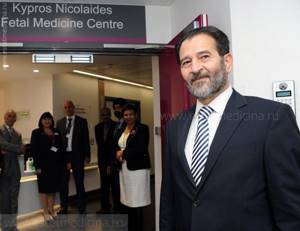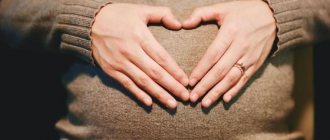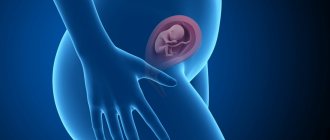Today we are talking about prenatal screening in the first trimester of pregnancy (weeks 11-13)
.
The head of the medical department of echography and prenatal diagnostics, an expert in the field of prenatal diagnostics, ultrasound diagnostics doctor, doctor of the highest category, Natalia Khramchenko
.
Natalya Vasilievna, tell us about screening at 11 weeks of pregnancy. What results does this study provide, and how important is this for a woman and her unborn child?
Screening of the first trimester of pregnancy, carried out from 11 to 13 weeks and 6 days, is an informative protocol study that is accepted and carried out in all countries of the world. Its legislator is Professor Kypros Nicolaides from England, London (Professor Kypros Nicolaides, Director of the Fetal Medicine Foundation). Under his leadership, the Astraed program was created, into which all the data of a pregnant woman is entered: information on the method of conception, all anthropometric data, information about previous diseases. After this, the embryo itself is examined; if the gestational age is more than 11 weeks, we are already talking about fetal examination. Measurements of certain markers or signs are taken: thickness of the collar space; presence and size of nasal bones; tricuspid insufficiency on the heart valve, ductus venosus. After entering the data, the program generates calculated risks for the diseases Down syndrome, Patau syndrome, Edwards syndrome.

Screening cannot be carried out until the embryo has reached a size of 45 mm, and the study is not carried out if the size is more than 85 mm (approximate gestation period of 13 weeks and 6 days). In these cases, the program simply will not make calculations; it contains parameters for a certain period of pregnancy. After the ultrasound examination, the woman must take a blood test from a vein. Combined ultrasound and blood test data are processed within one hour. After this short period of time, the woman learns about the presence or absence of the specified norms or pathologies of the embryo (fetus).
It is equally important that screening in our clinic allows us to examine all the child’s organs and determine the presence of various pathologies. Within the specified time frame, you can already see the presence of kidneys, intestines, stomach, and bladder. During this period, the child in the womb is already active.
At 11 weeks, it is more informative to donate blood; it is better to study anatomy after the 12th week of pregnancy. In 90% of cases, the gender of the child can be determined at this time. Why only 90%? 10% of girls have an enlarged clitoris, so they can pass themselves off as a boy. Also, if you examine the chambers of the heart, then gross anomalies can be excluded using Doppler currents. At 11 weeks of pregnancy, the size of the fetal heart is 4 mm, but already during this period 4 chambers can be identified and large defects can be seen. Closer to 12-13 weeks of pregnancy, the heart reaches a size of 8 mm, during this period it is already possible to exclude congenital heart defects. Similar studies at various stages of pregnancy are a worldwide practice.
And if any problem or pathology is identified – what to do?
If the program has calculated a high probability of having a child with various syndromes (for example, increased thickness of the nuchal translucency, absence or small size of the nasal bone, problems with insufficiency of the heart valve, or abnormal blood flow in the venous duct), we conduct a consultation meeting with a geneticist, which takes into account and result of a biochemical blood test. Based on the results of the meeting of the collegial council, we make a decision on further additional examination of this fetus. In the early stages of pregnancy (1st trimester), the chorionic biopsy method is used (a puncture is made through the abdomen and chorionic villi are taken for examination). Women are afraid of this method because of previously disseminated information about the risk of miscarriage as a complication during the process of collecting material for research. Now such risks are reduced to zero. The collection procedure takes place very correctly under ultrasound control. At a later stage of pregnancy, after 16 weeks, amniocentesis is performed (atraumatic sampling of fluid around the fetus), if chorionic villus biopsy was not performed in a timely manner. The liquid is examined under a microscope.
Ultrasound examination allows you to see a lot, but not everything, so additional diagnostic methods are used. For example, chromosomes can only be seen and analyzed under a microscope. Even if a child is born with Down syndrome, it may not be obvious from external signs, so only by analyzing the blood and examining it under a microscope can you get an accurate answer to the question about the number of chromosomes in a particular case.
How much does prenatal screening at 11 weeks of pregnancy cost in your clinic?
4000 rubles.
Thirteenth week for baby
The beginning of the week is characterized by a fetal length of 6-7 cm, and by the end it already reaches 10 cm, the weight of the unborn child at the moment is 20-30 grams.
This week marks the start of the second trimester of pregnancy. The fruit grows rapidly, its legs and arms lengthen. There is also a change in the proportions of the body; the head no longer looks as large as it did before. The future baby already knows how to reach his mouth with his finger and suck it, which is often seen by specialists during ultrasound diagnostics. In this way, the sucking reflex, which is so important for the baby in the first time after birth, finds its manifestation.
Intensive muscle growth occurs, especially noticeable in the leg area. The future baby becomes more active, his movements are now smoother. At this time, the woman is not able to feel the child, since he, being in the uterus, floats freely and does not actually come into contact with its walls. At this stage, the fetus completes the formation of the rudiments of all milk teeth. The rudiments are located in the mucous membrane of both jaws.
The gastrointestinal tract is also in a stage of active growth and development. Fitting into loops, the intestines completely fill the abdominal cavity. On the inner surface of the intestine, its mucous membrane, the formation of villi occurs, which should cover the entire internal area. After birth, these villi will help the baby absorb all the beneficial substances from the food in the intestinal cavity. The wave-like movements that the fetal intestines make help it push through amniotic fluid, which the unborn baby constantly swallows. These waters do not contain useful substances; they only help the intestines to train and form the necessary muscular system.
Embryo. 6 weeks from the moment of fertilization.
At week 6, it is already possible to distinguish the features of the future face. Limbs and fingers are developing. The baby begins to make his first movements. The pigment that determines the color of the eyes is formed on the iris. At week 6, the embryo's heartbeat can be seen and heard using an ultrasound scanner or ultrasound. The placenta is fully formed. The rudiments of the lungs, kidneys, gonads, stomach and intestines are formed. Amniotic fluid already surrounds the embryo. The 6th week of pregnancy in Western countries is considered the optimal time for the first visit to a gynecologist. It is necessary to do an ultrasound, undergo a series of tests, and undergo an examination by specialized specialists.
Thirteenth week for the expectant mother
At the thirteenth week, a woman begins to feel much better; she is finally able to feel only positive emotions associated with the anticipation of the baby’s arrival. Malaise, toxicosis and the desire to sleep are a thing of the past. The emotional background also undergoes changes. The woman becomes calmer and more peaceful; frequent mood swings and irritability also become a thing of the past. This is due to the end of the critical stages of pregnancy and more stable hormonal levels.
This period for most expectant mothers is associated with a change in the shape of the abdomen. Such changes are not yet noticeable to others, but the woman herself clearly sees the resulting roundness and feels discomfort when wearing ordinary things. It's time to pay attention to the selection of special clothing that can create comfortable conditions for the woman and the unborn baby.
Tests and ultrasound
If you have not done a scheduled ultrasound earlier, it can be done at week 13, as well as an analysis to determine the biochemical composition of the blood (without it, the ultrasound result will be incomplete). Doctors call ultrasound screening of pregnant women at a specified period “genetic”; its main purpose is to identify congenital malformations (Down syndrome, Edwards syndrome, neural tube defect). If abnormalities are detected, the pregnant woman is usually referred for consultation to a geneticist - he will more accurately determine the risk of having a child with a serious pathology. But sometimes screening gives a false positive result, which every expectant mother should definitely know about.
Fourteenth week for baby
At this stage, the weight of the fetus is 40-45 grams, its length is 13 cm.
The distinct formation of the face leads to a change in the appearance of the fetus. The bridge of the nose becomes more pronounced, the eyebrows are outlined, and the cheeks are rounded. The child moves, he feels his tummy and cheeks, holds on to the umbilical cord. The embryonic fluff, which covers the entire body, is tightly adjacent to the skin of the fetus. This gun has a protective function - it retains a special lubricant that will allow the baby to easily pass through the birth canal during the birth process. Over time, the almost transparent birth fuzz will be replaced by thicker hairs.
Important processes occur in the fetal respiratory organs precisely in the fourteenth week. Muscle tissues of not only the motor system, but also the respiratory system also develop. The fetus begins to imitate breathing with its movements. Such training is of great importance for the future baby, since he must take his first breath immediately after birth. His respiratory organs, under the influence of signals from the brain, must open and begin to function fully. At this stage, the glottis partially opens, so amniotic fluid penetrates into the respiratory organs during inhalation. Next, an intense exhalation occurs, and they are pushed out of the body of the unborn child. Flushing the lung tissues with amniotic fluid promotes their proper maturation.
Changes occur in the structure of the genital organs. In boys, intensive formation of the prostate begins; in girls, the ovaries, which were previously located in the abdominal cavity, move to the pelvic area. Differentiation of the external genitalia occurs, but during ultrasound examination at this stage it is not always possible to determine the sex of the unborn child.
The organs of the endocrine system also develop. An important event is the start of the pancreas. Insulin, an important hormone that regulates glucose levels in the body, also begins to be produced. This week, the pituitary gland begins to function, regulating the functioning of all glands of the body, responsible for their coherence, interaction, as well as the process of growth of the fetus and child in the future. The pituitary gland is located in the most protected part - surrounded by the bones of the skull, in the thickness of the brain.
Embryo 12 weeks - 13 weeks
Embryo 12 weeks. Photo
During this period, you can visit a doctor and have an ultrasound examination done in 3D reconstruction mode. Here is your baby's first portrait. Ultrasound can determine the sex of the child with almost 100% accuracy. During an ultrasound, screening for developmental pathologies is carried out. The finger can now be sucked - the sucking reflex has appeared. The liver and pancreas produce secretions. Meconium is formed in the intestines - original feces. The formation of the genital organs is completed. The baby's height is about 15 cm, weight 40-50 g. Despite the fact that the child is so small, he is already a person. All organs are in their places, now his body will be more resistant to negative influences. All that remains is to grow. The first trimester is over.
Fourteenth week for the expectant mother
A woman’s uterus is rapidly enlarging; it becomes possible to independently palpate its uppermost part through the anterior abdominal wall - the bottom, which will be 10-15 cm above the pubis. It's time for a woman to purchase special care products that will help nourish her skin and make it able to calmly endure the upcoming changes.
Striae - stretch marks on the skin that occur in many women are the result of microcracks, i.e. ruptures of connective fibers. The elasticity and firmness of the skin are significantly reduced, so even a small increase in weight can cause microcracks. Subcutaneous fat is redistributed and swelling may occur, so special care is simply necessary. Creams, lotions and other products for pregnant women are characterized by nutritious, safe compositions; they will help the skin restore elasticity and firmness, and prevent the appearance of stretch marks. Even if stretch marks occur due to excessive weight gain, their number will be minimal.
Embryo 20 weeks -30 weeks
Did you feel the kick? Now the baby communicates with his mother this way. If mom is sad, upset about something, or there is loud music around, it’s smoky, stuffy, the baby violently expresses his opinion. At first it’s timid, but by the end of pregnancy this method of communication will no longer cause tenderness. Constantly getting kicked from the inside can be quite painful. A sudden noise or fright of the mother leads to a similar response from the child. Protective reflexes arise.
In the lungs, the formation of respiratory alveoli is completed. Fingerprints form on hands. Brain development occurs at the fastest rate. Neural connections are formed. The baby can blink. The immune system is formed. The respiratory organs are developed enough to provide breathing in the event of premature birth, but sometimes only with medical assistance and special equipment. Adipose tissue appears. By 30 weeks, growth reaches 40-43 cm, weight up to 1.5 kg.
Fifteenth week for baby
At the end of the fifteenth week, the weight of the fetus is already about 50-70 grams, its length is 14-15 cm. The limbs grow, they can outstrip the size of the head due to the intensive development of the bones of the legs and arms. The future baby begins to actively bend his fingers and elbows, a unique skin pattern appears on the palms and fingers, and the process of nail formation begins.
At this stage, the cardiovascular system is improved. The number of heart beats per minute is twice as high as my mother’s and is 140-160. A tiny heart pumps 20 liters of blood per day, contributing to the intensive development of the body. The fetus's veins and arteries are actively growing, and the circulatory system is generally improving. Each internal organ develops its own system of veins and arteries - kidneys, lungs, heart, brain, etc. The fruit takes on an unusual red color instead of pink, since it has very thin skin, and the circulatory system, as it develops, affects its color.
At this time, the nervous system undergoes important stages of formation. The mass of the brain increases, its grooves and convolutions increase. Nerve fibers intertwine all muscles, internal organs and bones. A strong and stable connection is established between the central nervous system and the peripheral one. Impulses begin to flow in both directions: from the brain to the organs and back. An important “feedback” system for the human body is emerging.
If before the fifteenth week red blood cells (erythrocytes) were produced by the bile sac and liver, then after this stage this function begins to be performed by the red bone marrow located inside the bones.
It is already possible to determine the blood type and Rh factor of the unborn baby. The formation of the group and Rhesus occurs at the moment of conception of the baby, however, this information is realized only in the fifteenth week. The formation of special proteins-antigens occurs, which appear on the surface of red blood cells.
Embryo 5 - 6 weeks
Embryo. 5 weeks from the moment of fertilization.
At 5 weeks, the umbilical cord is formed, which will connect the baby to the placenta. The umbilical cord contains arteries and veins. The length of the umbilical cord by the end of childbirth can reach 70 cm. At the 5th week, the arms and legs look like flippers, but individual details can already be distinguished. The first impulses begin to be generated in the nervous system - the basis of nervous activity. The head of the embryo is formed, and holes for the ears, eyes, mouth and nose appear in it. The length of the embryo reaches 1 cm.
Fifteenth week for the expectant mother
A woman’s abdomen grows quite smoothly; it increases gradually and does not cause discomfort in everyday life. The fundus of the uterus can already be palpated through the anterior abdominal cavity at a height of 15-20 cm from the pubis.
The body intensively produces the pigment melanin, which is deposited in the skin. This process is caused by hormonal levels and causes the appearance of pigment spots on the surface of the skin, which can form in completely different places. Often a dark stripe appears on the abdomen, which has a brown tint and runs from the navel to the pubis. Rarely, the cause of increased melanin synthesis is a lack of vitamins in the body.
Age spots should appear without any sensation. If their occurrence is accompanied by swelling, redness or discomfort, you should see a doctor. Such reactions may be the result of allergies or dermatosis of pregnancy, a common skin disease. Pigment spots can have a different shade - from light beige to dark brown. Almost always, such manifestations disappear on their own after the baby is born. The use of whitening creams during pregnancy is possible only after consultation with a doctor, as they may be unsafe for the fetus.
Embryo 16 weeks -19 weeks
Marigolds appeared on my fingers. Taste buds on the tongue can sense taste, and receptors in the nose can sense smell. Mom may or may not like the foods she eats. Fully formed ears make it possible to hear sounds. Including mom's heartbeat. Recent research has led to an original practical application - soft toys are made for newborn children that reproduce the mother's heartbeat. It is believed that a calm, measured heartbeat calms the baby. Try not to be nervous. The eyes begin to discern light.
And of course, during this period, mothers begin to feel the baby’s movements inside them. There is feedback from the mother. The baby can sleep and be awake, this is noticeable by periods when no movements are felt. Baby's height is 20 cm and weight is up to 250 g.
Sixteenth week for baby
The formation of facial muscles in the fetus occurs, it begins to develop them, which is expressed in frowning of the eyebrows, opening and closing of the mouth. The fetus gets the opportunity to open its eyes for the first time, which until this moment were tightly covered with eyelids, and it begins to learn to blink. In place of eyelashes and eyebrows you can see thin vellus hairs. If before this stage the ears were located out of place, closer to the neck, now they are already placed like in an adult. Although the fetus has a pronounced reaction to loud sounds, at this stage its middle ear is not yet able to hear. The reaction is due to such a method of perception as bone conduction. It turns out that the fetus hears through dense parts of the body (bones).
The unborn baby has already completed the process of forming all joints and bones. The process of ossification, i.e., compaction of bone tissue, will continue not only throughout the remaining period, but also after birth, almost until puberty.
When conducting an ultrasound examination, it is already possible to reliably determine the sex of the child, since his external genitalia are fully formed. It is at this time or a little later (depending on the time of the appointed diagnosis) that the mother gets the opportunity to find out who she will give birth to.
The fetus's kidneys work intensively. Now they begin to perform a partial excretory function, slightly reducing the load that lies on the placenta. The urinary canal is formed, the fetus daily swallows 300-500 mm of amniotic fluid, they pass through its intestines and are excreted by the kidneys. Urination is performed in small portions every hour, urine enters the amniotic fluid.
Embryo 8 weeks
The kidneys begin to produce urine. Hair follicles form in the skin. Almost all vital organs have already been formed. Reflexes and feelings are triggered. Ears form, the face no longer looks like an alien from a science fiction movie. It is clearly visible that a person is growing. The bones are still made of cartilage, but later they will be saturated with calcium and turn into real bone tissue. This process will be completely completed only by the age of 25, long after birth. The size of the embryo is almost 2 cm.
Sixteenth week for the expectant mother
At this stage, the woman feels a significant improvement in her health. Gradual weight gain begins and appetite normalizes. The norm at the moment is considered to be a gain of 2.5-3 kg.
At the moment, there is both active growth of the unborn baby and a significant accumulation of amniotic fluid. Both of these factors influence the growth of the abdomen; its increasing volume does not yet cause discomfort. However, it's time to make changes to your habits, for example, changing your body position while sleeping. Sleeping on your back is just as inadvisable as sleeping on your stomach. When sleeping on your back, the uterus can put pressure on large veins, which will impair the outflow of blood and cause swelling, cramps and varicose veins. The most comfortable sleeping position is on the side, in which both the unborn baby and the mother will feel as comfortable as possible.
Beauty and accessories
Have you already bought new pants without a zipper and a bra with wide straps without wires? Now you should think about special tights for pregnant women, since in ordinary ones a woman feels uncomfortable due to the appearance of her belly. Special products with an elastic insert for the abdomen can be purchased in departments for expectant mothers, as well as in specialized online stores. These tights come in a variety of colors. A pregnant woman will be comfortable in them even in the later stages of an “interesting situation.”







